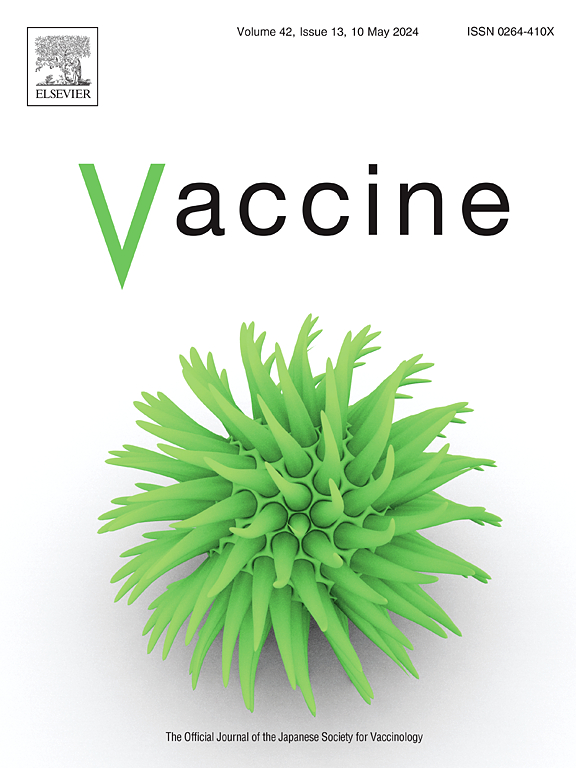加拿大安大略省以人群为基础的艾滋病毒感染者和非艾滋病毒感染者回顾性队列中的COVID-19疫苗接种情况
IF 4.5
3区 医学
Q2 IMMUNOLOGY
引用次数: 0
摘要
covid -19疫苗接种可显著降低与covid -19相关的住院率和死亡率,对那些感染SARS-CoV-2风险可能增加的人(包括艾滋病毒感染者)非常重要。使用基于人群的方法,我们检查了加拿大安大略省艾滋病毒感染者和非艾滋病毒感染者的COVID-19疫苗接种情况。方法利用2020年12月14日至2022年8月31日的省级临床和卫生行政资料进行回顾性人群匹配队列研究。根据年龄、性别、地理位置和移民身份,将居住在社区的年龄≥19岁的艾滋病毒感染者与未诊断出艾滋病毒的人进行一对一匹配。为了确定疫苗摄取的预测因子,使用了考虑地理聚类的修正泊松回归和鲁棒标准误差。为了估计比较HIV和非HIV队列的疫苗摄取,使用具有稳健误差方差的条件泊松回归以95%的置信区间(CI)估计粗风险比和调整风险比。结果20903名HIV感染者中,大多数(85.4%)接种了≥2剂COVID-19疫苗,其中64.7%接种了第三剂,24.3%接种了第四剂。在≥3剂的摄取上观察到性别差异(男性vs女性:68.5% vs 50.9%)。艾滋病毒感染者接受≥3剂疫苗的预测因素包括年龄较大、男性和最近接种过流感疫苗。与未感染艾滋病毒的男性相比,感染艾滋病毒的男性接受≥3次剂量的可能性更大,而感染艾滋病毒的女性接受≥3次剂量的可能性低于未感染艾滋病毒的女性。结论加拿大安大略省艾滋病毒感染者前两剂COVID-19疫苗的接种率很高,但≥3剂的接种率仍然存在差异,性别差异尤其明显。持续监测COVID-19疫苗接种情况对于为加拿大艾滋病毒感染者的免疫规划、政策和指南提供信息至关重要。本文章由计算机程序翻译,如有差异,请以英文原文为准。
COVID-19 vaccine uptake in a retrospective population-based cohort of people living with and without HIV in Ontario, Canada
Introduction
COVID-19 vaccination significantly reduces COVID-19-related hospitalization and mortality and is important for those who may be at increased risk of SARS-CoV-2 infection, including people living with HIV. Using a population-based approach, we examined COVID-19 vaccine uptake among people living with and without HIV in Ontario, Canada.
Methods
A retrospective population-based matched cohort study was conducted using provincial clinical and health administrative data from December 14, 2020 to August 31, 2022. Community-dwelling adults living with HIV aged ≥19 years were matched one-to-one with a person without a diagnosis of HIV based on age, sex, geography, and immigration status. To identify predictors of vaccine uptake, modified Poisson regression with robust standard errors accounting for geographical clustering was used. To estimate vaccine uptake comparing the HIV and non-HIV cohorts, conditional Poisson regression with robust error variance was used to estimate crude and adjusted risk ratios with 95 % confidence intervals (CI).
Results
Among 20,903 people living with HIV, most (85.4%) had received ≥2 COVID-19 vaccine doses, with 64.7% receiving a third dose and 24.3% receiving a fourth dose. Disparities in uptake of ≥3 doses by sex were observed (males vs females: 68.5% vs 50.9%). Predictors of receiving ≥3 doses among people living with HIV included older age, male sex, and receipt of a recent influenza vaccine. Men living with HIV were more likely to receive ≥3 doses compared with men living without HIV, whereas women living with HIV were less likely than women living without HIV to receive ≥3 doses.
Conclusions
Uptake of the first two doses of COVID-19 vaccine was high among people living with HIV in Ontario, Canada, however, disparities in uptake of ≥3 doses remain, especially by sex. Continued monitoring of COVID-19 vaccine uptake is crucial to informing immunization programs, policies and guidelines for people living with HIV in Canada.
求助全文
通过发布文献求助,成功后即可免费获取论文全文。
去求助
来源期刊

Vaccine
医学-免疫学
CiteScore
8.70
自引率
5.50%
发文量
992
审稿时长
131 days
期刊介绍:
Vaccine is unique in publishing the highest quality science across all disciplines relevant to the field of vaccinology - all original article submissions across basic and clinical research, vaccine manufacturing, history, public policy, behavioral science and ethics, social sciences, safety, and many other related areas are welcomed. The submission categories as given in the Guide for Authors indicate where we receive the most papers. Papers outside these major areas are also welcome and authors are encouraged to contact us with specific questions.
 求助内容:
求助内容: 应助结果提醒方式:
应助结果提醒方式:


